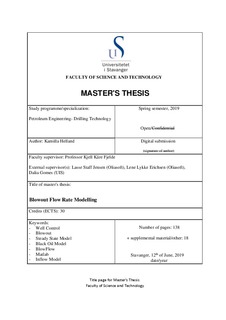| dc.description.abstract | A blowout represent one of the major concerns associated with drilling, completion, maintenance and production of an oil field. Calculation of blowout rate is commonly one of the first steps in an Environmental Risk Analysis, as well as being a measure of the environmental and economic damage caused by a blowout. An increasing focus on preserving and protecting the environment, enlarges the requirement for improved numerical simulators within well control assessment. BlowFlow is an example of a software tool applied for oil-spill calculations. The engine combines flow modelling with uncertainty modelling to produce statistical distributions of blowout rates, volumes and duration. A simulation example performed in Oliasoft Blowout Simulator is presented in this thesis to illustrate a possible approach of performing oil-spill calculations.
A numerical simulator based on the black oil model, multiphase flow model, simple friction model and inflow model, has been developed with the purpose of estimating blowout rates. The starting point was a steady two-phase flow model developed by Gomes (2016). This code has been tested and documented, resulting in a number of modifications. The major improvement made to this point, is that the program is extended to include an inflow model for both single-phase and multiphase inflow conditions. Because the modified model is based on an initial guess of the BHP, while utilizing a shooting technique from the bottom of the well and up, made it possible to determine the actual oil inflow rate of a blowing well directly from the simulation.
This study provides an overview of two modelling approaches available for simulating blowout rates. Both methods presents reasonable result depending on the conditions in the reservoir. The case studies shows that the approach varying the liquid rates at surface conditions, and finding a solution at the intersection point between the IPR and TPR curves, is less efficient than implementing an inflow directly in the simulator. This is the case as long as the model is based on a technique of numerical calculation from bottom to top. | nb_NO |
